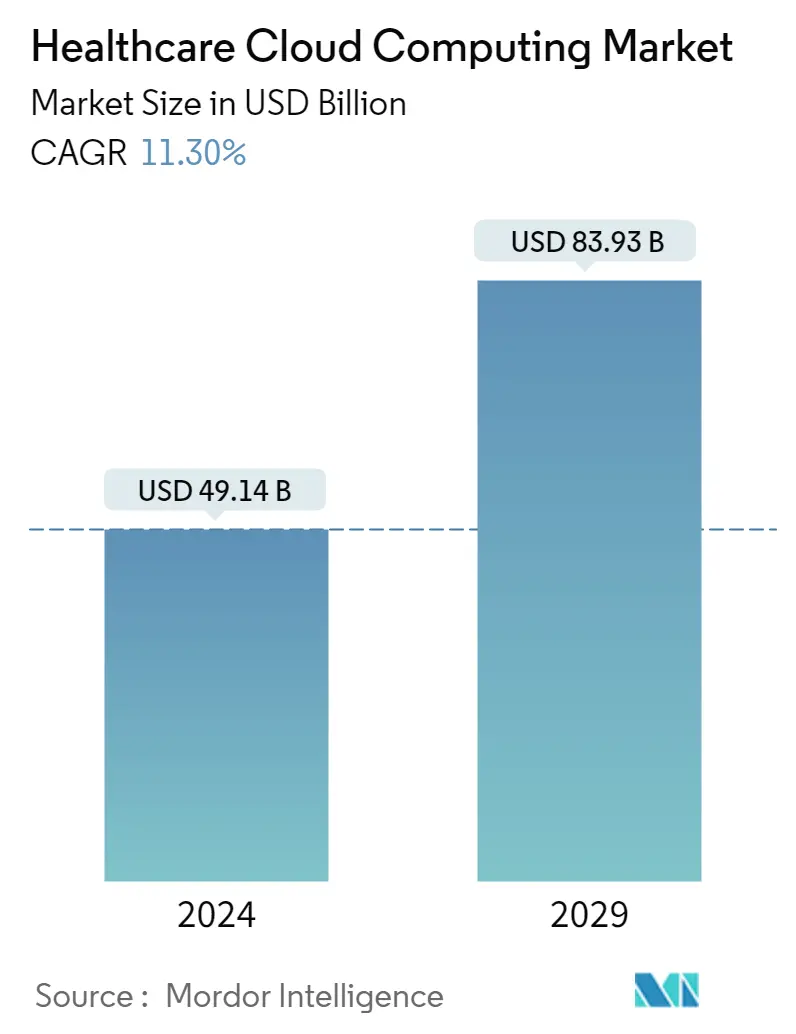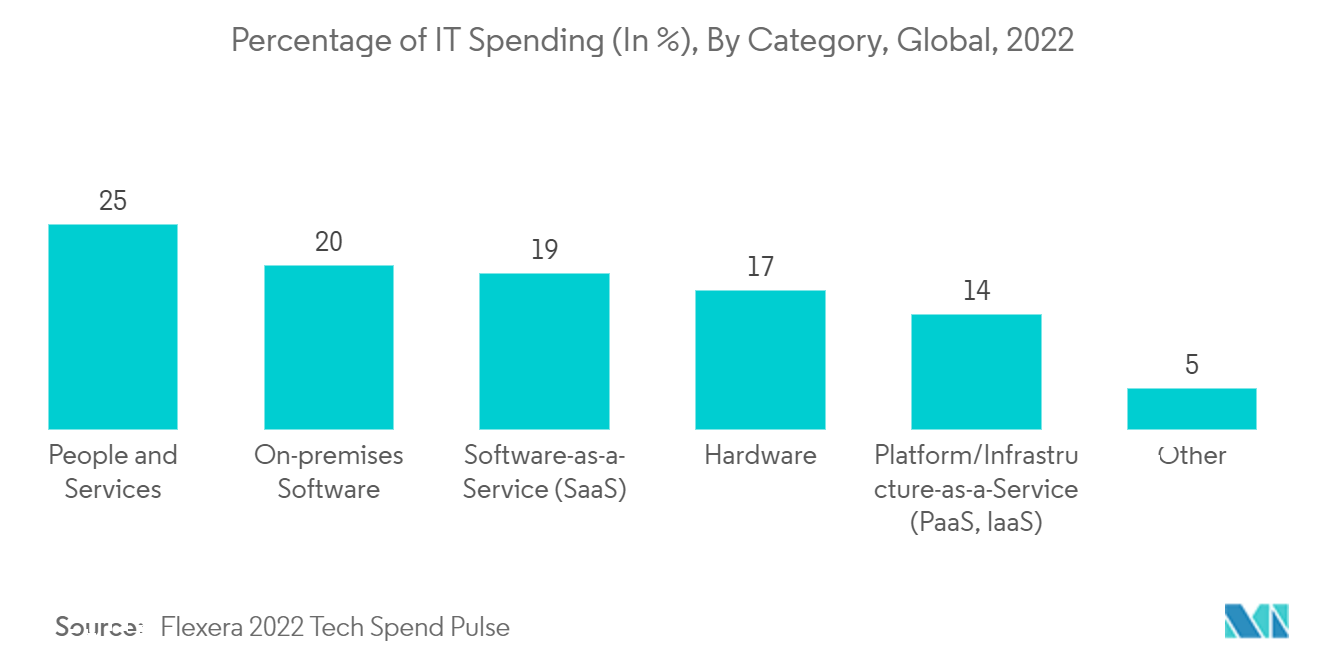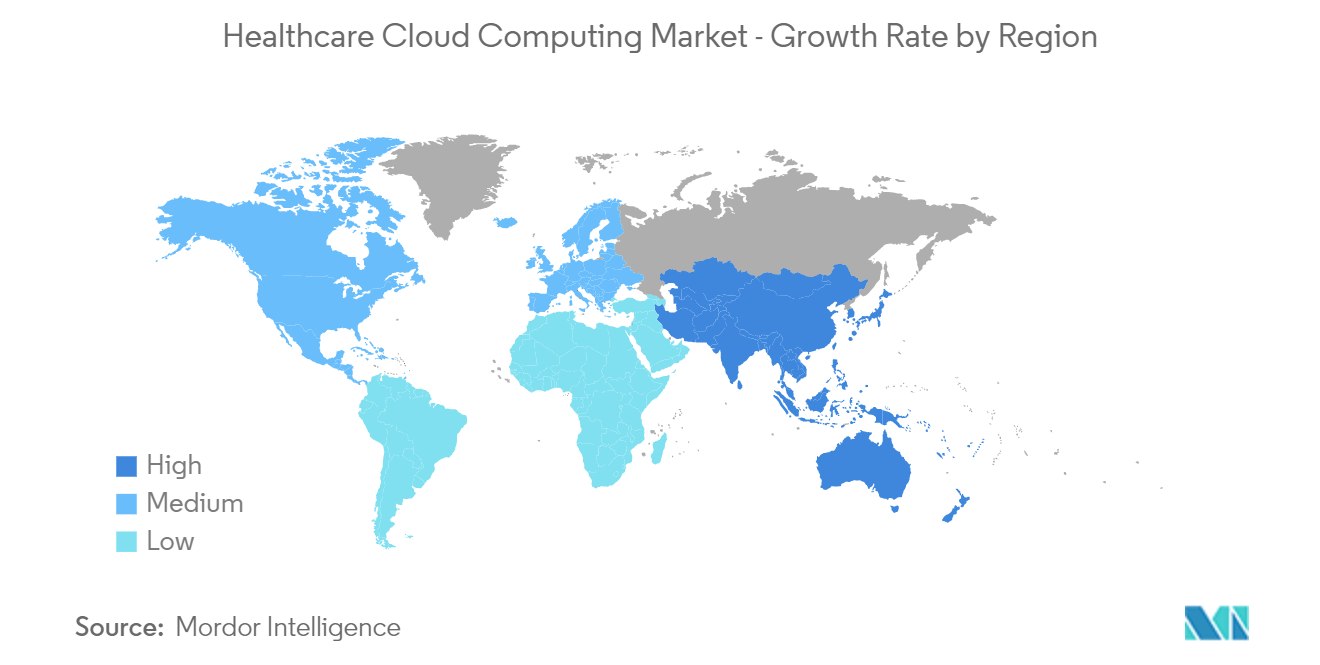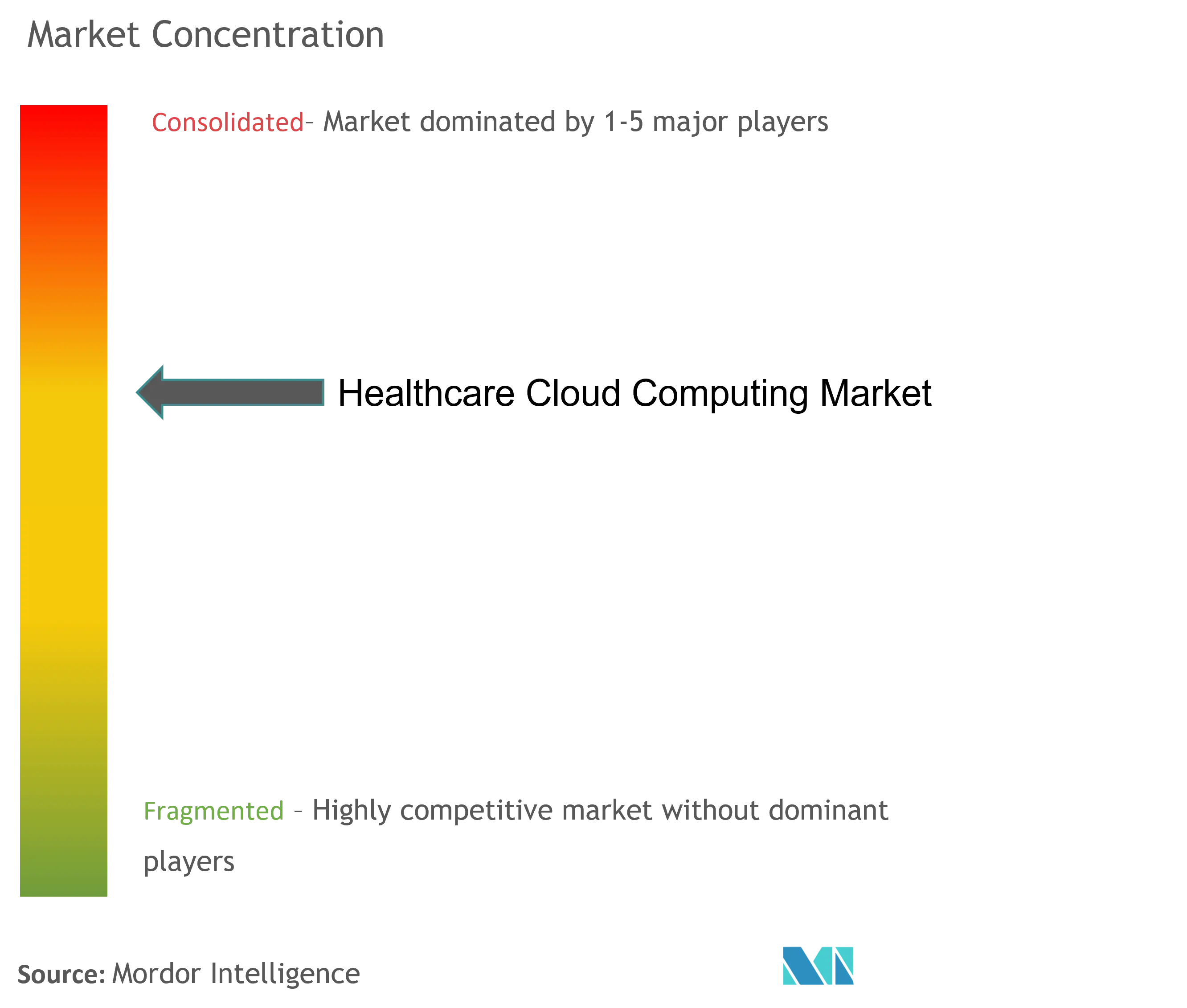Healthcare Cloud Computing Market Size

| Study Period | 2021 - 2029 |
| Market Size (2024) | USD 49.14 Billion |
| Market Size (2029) | USD 83.93 Billion |
| CAGR (2024 - 2029) | 11.30 % |
| Fastest Growing Market | Asia-Pacific |
| Largest Market | North America |
Major Players
*Disclaimer: Major Players sorted in no particular order |
Healthcare Cloud Computing Market Analysis
The Healthcare Cloud Computing Market size is estimated at USD 49.14 billion in 2024, and is expected to reach USD 83.93 billion by 2029, growing at a CAGR of 11.30% during the forecast period (2024-2029).
The COVID-19 pandemic is expected to have an overall positive effect on the market. The management of a vast amount of data has been one of the main problems the healthcare industry has faced, particularly in light of the increasing demands brought on by the pandemic. To collect, store, and analyze data to improve healthcare operations further, cloud technology has been and maybe a significant help in this area. Cloud-based solutions enable healthcare organizations to only pay for the resources they use by decentralizing the system. Cloud computing technologies enable healthcare organizations to track and map diseases and notify the public about areas where risk is present at a significantly cheaper cost and faster rate. For instance, as per the report of NHC of the people's republic of China, in November 2022, there were 1,794 new cases of COVID-19 reported in various areas of China. Hence, tracking and mapping the disease is made easy with cloud computing and is expected to positively impact the market over the coming years due to continuing booster vaccination and new COVID-19 cases.
The major factors bolstering the growth of the healthcare cloud computing market include increasing access to advanced technology, such as machine learning, the rise in the adoption of information technology in the healthcare sector, and the usage of the cloud for reducing cost and improving scalability, storage, and flexibility. Following the epidemic, which forced healthcare leaders to adapt and innovate in ways they had never done before, they are embracing the advantages of the cloud and software as a service (SaaS). Hence, there is an increase in the adoption of information technology advancements in cloud technologies for healthcare and life sciences, increasing the demand for cloud computing. For instance, as per the report published by Philips in June 2022, 66% of healthcare leaders expect to move their technology infrastructures to the cloud in 2022, which is set to rise to 96% by 2024.
Similarly, in March 2022, Microsoft Corp. expanded its healthcare cloud strategy with new solutions and capabilities across data, artificial intelligence, and clinician experiences. Thus, the increase in the adoption of technology and advancements in cloud computing in the healthcare sector increases the demand for healthcare cloud computing which drives the market growth over the forecast period. However, the factors such as data security and integrity issues and lack of interoperability and industry standards hinder the market's growth over the forecast period.
Healthcare Cloud Computing Market Trends
This section covers the major market trends shaping the Healthcare Cloud Computing Market according to our research experts:
Electronic Health Record (EHR) Segment is Expected to Hold the Largest Market Share Over the Forecast Period
An electronic health record (EHR) is an electronic record of patient health information that includes vital signs, patient demographics, progress notes, problems, past medical history, medications, laboratory data, immunizations, and radiology reports. Since EHR systems can be multi-disciplinary, they can be utilized to collect and analyze data from public health departments, healthcare organizations, and socioeconomic indicators. Complex healthcare systems require diverse EHR products to share information seamlessly.
For instance, in March 2022, Microsoft launched a new feature through Microsoft Teams EHR connector for Cerner. The new Cerner-validated application expands the capabilities of the Microsoft Teams EHR connector, making it easier for clinicians to launch virtual appointments with patients or consult with other providers in Teams directly from Cerner PowerChart, effortlessly invite other care team members to virtual appointments, and gain real-time status reports of their visits to help improve patient care. Thus with the cloud EHR, the work for the healthcare team became easy, thereby driving the market over the study period.
Furthermore, the agreements and partnerships among the major players in the market towards cloud computing drive the market. For instance, in January 2022, Visionflex entered a partnership agreement with MediRecords, Australia's provider of cloud-based electronic medical record and practice management systems. The partnership will see the companies work toward integrating Visionflex's video conferencing platform, Vision, with MediRecords' cloud-based electronic health record and practice management software platforms. By enabling better workflows and reducing ambiguity, interoperable EHR quickly allows data transfer between EHR systems and healthcare stakeholders. Thus, the market is expected to witness the largest market share in this segment over the forecast period due to the abovementioned factors.

North America is Expected for the Largest Market Share Over the Forecast Period
North America holds a significant share of the healthcare cloud computing market and is expected to show a similar trend over the forecast period. The United States is a leader in the healthcare cloud computing market, mainly due to the high adoption rate of healthcare IT services and the continuous financial and regulatory support from government agencies.
According to the report of Zivaro, an IT service management company, published in June 2022, the growth of medical data interoperability is the main force behind innovation in cloud computing. Numerous healthcare organizations around the United States produce enormous amounts of medical data. Cloud computing is widely used, which is understandable given the complexity of HIPAA and HITECH governance rules for electronic Protected Health Information (ePHI). It also states that data can be imported and exported into shared database platforms, allowing application services to safely share information inside and outside a secured network architecture, using practically limitless cloud storage solutions. Thus the above factors will help the market to grow in the coming future.
Furthermore, the new partnership and collaborations among the major players in healthcare cloud computing help the market to grow. For instance, in September 2022, LifePoint Health, a diversified healthcare delivery network dedicated to making communities healthier, and Google Cloud entered a multi-year strategic partnership to transform healthcare delivery in communities across the United States through LifePoint's implementation of Google Cloud's Healthcare Data Engine (HDE). Thus the new partnerships towards healthcare cloud computing in the region help to drive the market over the study period.
Thus, the market is expected to witness the largest market share over the forecast period due to all the aforementioned factors.

Healthcare Cloud Computing Industry Overview
The healthcare cloud computing market is moderately consolidated, owing to the presence of a few key players in the market. Companies are applying powerful competitive strategies to gain more market share. The companies are involved in various strategies such as product launches and investments in R&D activities to sustain themselves in the highly competitive environment. Some of the market players are Amazon.com, Inc., Dell Inc., IBM Corporation, Oracle, Athenahealth Inc., CareCloud, Inc., ZYMR Inc., ClearDATA, Iron Mountain Incorporated, Siemens Healthcare GmbH, e-Zest Solutions, OSP Labs, Euris, Microsoft and Koninklijke Philips NV.
Healthcare Cloud Computing Market Leaders
-
Dell Inc.
-
IBM Corporation
-
Koninklijke Philips NV
-
Amazon.com, Inc.
-
Oracle
*Disclaimer: Major Players sorted in no particular order

Healthcare Cloud Computing Market News
- In November 2022, Wipro Ltd partnered with the United States-based cloud computing service provider VMware. The partnership will see Wipro maintain a VMware business unit to offer its clients the latter's platform as a service. Wipro is training up to 5,000 professionals in VMware's cross-cloud services, which will offer multi-cloud enterprise tools and focus on sectors such as banking, financial services and insurance (BFSI), healthcare, and consumer and retail services, as per the statement.
- In June 2022, Saudi Arabia's Ministry of Health (MoH) deployed multi-cloud solutions from VMware to transform the country's public healthcare sector digitally. With this Ministry can offer secure, cloud-based services to public healthcare providers, including hospitals, clinics, and pharmacies, significantly boosting their efficiency and enabling them to grow and innovate.
Healthcare Cloud Computing Market Report - Table of Contents
1. INTRODUCTION
- 1.1 Study Assumptions and Market Definition
- 1.2 Scope of the Study
2. RESEARCH METHODOLOGY
3. EXECUTIVE SUMMARY
4. MARKET DYNAMICS
- 4.1 Market Overview
-
4.2 Market Drivers
- 4.2.1 Increase in Adoption of Information Technology in the Healthcare Sector
- 4.2.2 Access to Advanced Technology, Such as Machine Learning, is Easier on Cloud Systems
- 4.2.3 Usage of Cloud Reduces Cost and Improves Scalability, Storage, and Flexibility
-
4.3 Market Restraints
- 4.3.1 Data Security and Integrity Issues
- 4.3.2 Lack of Interoperability and Industry Standards
-
4.4 Porter's Five Forces Analysis
- 4.4.1 Threat of New Entrants
- 4.4.2 Bargaining Power of Buyers/Consumers
- 4.4.3 Bargaining Power of Suppliers
- 4.4.4 Threat of Substitute Products
- 4.4.5 Intensity of Competitive Rivalry
5. MARKET SEGMENTATION (Market Size by Value - USD Million)
-
5.1 By Application
- 5.1.1 Clinical Information Systems (CIS)
- 5.1.1.1 Electronic Health Record (EHR)
- 5.1.1.2 Picture Archiving and Communication System (PACS)
- 5.1.1.3 Radiology Information Systems (RIS)
- 5.1.1.4 Computerized Physician Order Entry (CPOE)
- 5.1.1.5 Other Applications
- 5.1.2 Non-clinical Information Systems (NCIS)
- 5.1.2.1 Revenue Cycle Management (RCM)
- 5.1.2.2 Automatic Patient Billing (APB)
- 5.1.2.3 Payroll Management System
- 5.1.2.4 Other Non-clinical Information Systems
-
5.2 By Deployment
- 5.2.1 Private Cloud
- 5.2.2 Public Cloud
-
5.3 By Service
- 5.3.1 Software-as-a-Service (SaaS)
- 5.3.2 Infrastructure-as-a-Service (IaaS)
- 5.3.3 Platform-as-a-Service (PaaS)
-
5.4 By End User
- 5.4.1 Healthcare Providers
- 5.4.2 Healthcare Payers
-
5.5 Geography
- 5.5.1 North America
- 5.5.1.1 United States
- 5.5.1.2 Canada
- 5.5.1.3 Mexico
- 5.5.2 Europe
- 5.5.2.1 Germany
- 5.5.2.2 United Kingdom
- 5.5.2.3 France
- 5.5.2.4 Italy
- 5.5.2.5 Spain
- 5.5.2.6 Rest of Europe
- 5.5.3 Asia Pacific
- 5.5.3.1 China
- 5.5.3.2 Japan
- 5.5.3.3 India
- 5.5.3.4 Australia
- 5.5.3.5 South Korea
- 5.5.3.6 Rest of Asia Pacific
- 5.5.4 Middle East and Africa
- 5.5.4.1 GCC
- 5.5.4.2 South Africa
- 5.5.4.3 Rest of Middle East and Africa
- 5.5.5 South America
- 5.5.5.1 Brazil
- 5.5.5.2 Argentina
- 5.5.5.3 Rest of South America
6. COMPETITIVE LANDSCAPE
-
6.1 Company Profiles
- 6.1.1 Amazon.com, Inc.
- 6.1.2 Athenahealth Inc.
- 6.1.3 CareCloud, Inc.
- 6.1.4 ZYMR Inc.
- 6.1.5 ClearDATA
- 6.1.6 Dell Inc.
- 6.1.7 IBM Corporation
- 6.1.8 Iron Mountain Incorporated
- 6.1.9 Oracle
- 6.1.10 Siemens Healthcare GmbH
- 6.1.11 Koninklijke Philips NV
- 6.1.12 e-Zest Solutions
- 6.1.13 OSP Labs
- 6.1.14 Euris
- 6.1.15 Microsoft
- *List Not Exhaustive
7. MARKET OPPORTUNITIES AND FUTURE TRENDS
** Subject To AvailablityHealthcare Cloud Computing Industry Segmentation
As per the scope of this report, cloud computing has been defined as the practice of using remote servers in place of local servers or networks to store, manage, and process data. Therefore, using the cloud moves the data center infrastructure outside the organization. This report analyzes and discusses the market for cloud computing in the healthcare sector. The revenue from cloud services has been tracked in the report. The healthcare cloud computing market is segmented by application (Clinical Information Systems (CIS) (Electronic Health Record (EHR), Picture Archiving and Communication System (PACS), Radiology Information Systems (RIS), Computerized Physician Order Entry (CPOE), and other applications) and Non-clinical Information Systems (NCIS) (Revenue Cycle Management (RCM), Automatic Patient Billing (APB), Payroll Management System, and other Non-clinical Information Systems)), Deployment (Private Cloud and Public Cloud), Service (Software-as-a-Service (SaaS), Infrastructure-as-a-Service (IaaS), and Platform-as-a-Service (PaaS)), end user (Healthcare Providers and Healthcare Payers), and Geography (North America, Europe, Asia Pacific, Middle East and Africa, and South America). The market report also covers the estimated market sizes and trends for 17 countries across major global regions. The report offers the value (USD million) for all the above segments.
| By Application | Clinical Information Systems (CIS) | Electronic Health Record (EHR) |
| Picture Archiving and Communication System (PACS) | ||
| Radiology Information Systems (RIS) | ||
| Computerized Physician Order Entry (CPOE) | ||
| Other Applications | ||
| By Application | Non-clinical Information Systems (NCIS) | Revenue Cycle Management (RCM) |
| Automatic Patient Billing (APB) | ||
| Payroll Management System | ||
| Other Non-clinical Information Systems | ||
| By Deployment | Private Cloud | |
| Public Cloud | ||
| By Service | Software-as-a-Service (SaaS) | |
| Infrastructure-as-a-Service (IaaS) | ||
| Platform-as-a-Service (PaaS) | ||
| By End User | Healthcare Providers | |
| Healthcare Payers | ||
| Geography | North America | United States |
| Canada | ||
| Mexico | ||
| Geography | Europe | Germany |
| United Kingdom | ||
| France | ||
| Italy | ||
| Spain | ||
| Rest of Europe | ||
| Geography | Asia Pacific | China |
| Japan | ||
| India | ||
| Australia | ||
| South Korea | ||
| Rest of Asia Pacific | ||
| Geography | Middle East and Africa | GCC |
| South Africa | ||
| Rest of Middle East and Africa | ||
| Geography | South America | Brazil |
| Argentina | ||
| Rest of South America |
Healthcare Cloud Computing Market Research FAQs
How big is the Healthcare Cloud Computing Market?
The Healthcare Cloud Computing Market size is expected to reach USD 49.14 billion in 2024 and grow at a CAGR of 11.30% to reach USD 83.93 billion by 2029.
What is the current Healthcare Cloud Computing Market size?
In 2024, the Healthcare Cloud Computing Market size is expected to reach USD 49.14 billion.
Who are the key players in Healthcare Cloud Computing Market?
Dell Inc., IBM Corporation, Koninklijke Philips NV, Amazon.com, Inc. and Oracle are the major companies operating in the Healthcare Cloud Computing Market.
Which is the fastest growing region in Healthcare Cloud Computing Market?
Asia-Pacific is estimated to grow at the highest CAGR over the forecast period (2024-2029).
Which region has the biggest share in Healthcare Cloud Computing Market?
In 2024, the North America accounts for the largest market share in Healthcare Cloud Computing Market.
What years does this Healthcare Cloud Computing Market cover, and what was the market size in 2023?
In 2023, the Healthcare Cloud Computing Market size was estimated at USD 44.15 billion. The report covers the Healthcare Cloud Computing Market historical market size for years: 2021, 2022 and 2023. The report also forecasts the Healthcare Cloud Computing Market size for years: 2024, 2025, 2026, 2027, 2028 and 2029.
Cloud Computing in Healthcare Industry Report
Statistics for the 2024 Cloud Computing in Healthcare market share, size and revenue growth rate, created by Mordor Intelligence™ Industry Reports. Cloud Computing in Healthcare analysis includes a market forecast outlook to 2029 and historical overview. Get a sample of this industry analysis as a free report PDF download.



